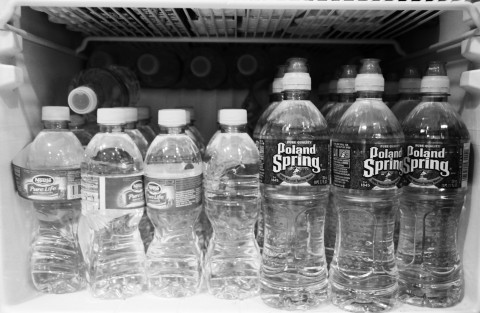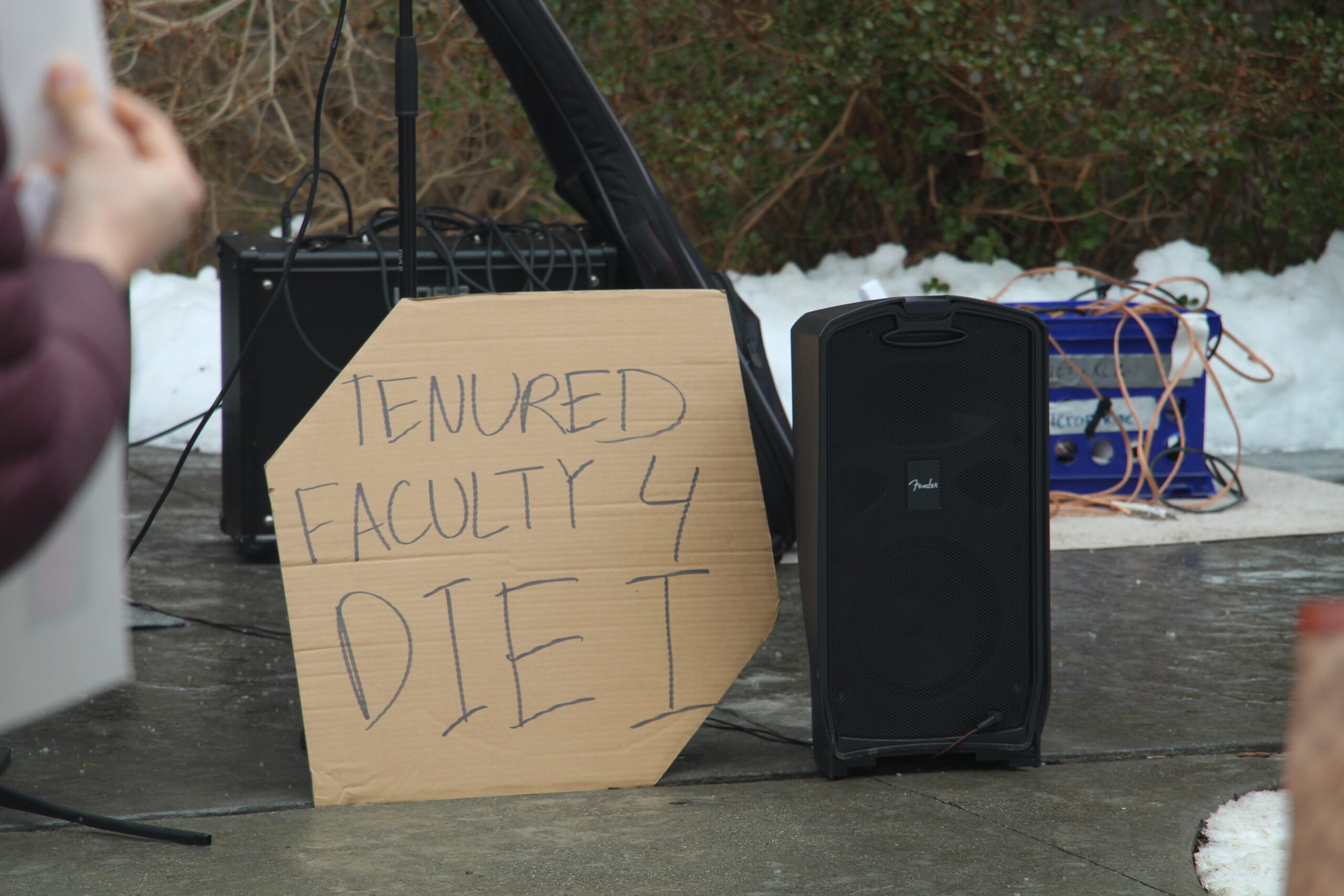
Water bottles in Cro. Photo by Julie McMahon.
Alex Schwartzburg ’12 sits in his room in Freeman late on a Wednesday night. Warm, bronze light glows from incandescent lamps. Piles of papers surround his laptop as he plugs away at an essay. As I walk in, he motions toward a tower of three twenty-four-packs of bottled water that lean against the wall next to his door. He offers me one and I decline. I notice multiple empty bottles are strewn across his desk.
“Stocking up?” I ask, knowing that Schwartzburg has recently learned about the proposed ban on the sale of bottled water on campus. Schwartzburg laughs, “You could say that.” This scene says all that needs to be said about Schwartzburg’s feelings about the recent environmental initiative, a feeling shared by many other students.
I caught up with Larrabee House Senator Allison Kipke ’13 to discuss this proposed ban, since it was a topic of conversation in SGA last week. When asked whether she supports or opposes the ban, Kipke responded, “I personally see both sides. Becoming more informed is a better way to approach this. How the campus is set up, we could not ban the sale of water.” Undoubtedly, Kipke is correct. Banning the sale of bottled water is a noble cause, as water bottles either end up as non-biodegradable waste or consume large amounts of energy in order to be recycled and converted into new water bottles or other plastic items. Having said this, it is not a practical course of action for our campus right now.
The main issue with banning the sale of water on our campus is the lack of water fountains. While sinks are a totally safe, viable option for drinking water, tap water tastes like chlorine and hard metals and is unappealing. Says Schwartzburg, “The non-bottled water sources available on campus tend to be pretty disgusting.” Many students do drink it anyway. Evan Bragdon ’12 says, “I don’t care if I can’t buy bottled water. I always just grab a cup and go to the sink.” And, to be honest, there is nothing wrong with us tip-toeing into our bathrooms late at night to lean over a Ramen-caked sink bowl and take a few swigs out of the faucet (“It’s no dirtier than beer pong!” a student might say in defense). However, as Kipke points out, there is always the difference between the environmental sacrifices we make in our private, not-worthy-of-a-picture-in-the-alumni-magazine lives, and those we make (or don’t make) when we are selling our school to parents or prospective students.
Kipke says, “There is a need for water, on tours and such. It would look bizarre if we didn’t sell water.” Kipke makes a strong argument. Unless we add at least one water fountain to every major building, including all dorms (no small undertaking), our visitors won’t remember our beautiful green or our tasty camel cookies. They’ll remember that they felt dehydrated while they were here and couldn’t wait to get off campus to buy some water.
Another reason to oppose the ban on the sale of bottled water on campus is simply that it won’t actually save enough waste to be worth the trouble of implementing it. The ban is not a ban on the possession of plastic water bottles, simply their sale on campus. Bringing us back to Schwartzburg, the ban does not change attitudes; it changes where we can get our water. Therefore, students can purchase bulk packages of water bottles at local retailers, as Schwartzburg and many other students already do, and carry those bottles around with them during the day. In that case, not only are our on campus vendors losing money to Wal-Mart and Target, but the waste created is equal to or greater than that created by selling the plastic water bottles on campus to begin with.
The clear answer to the dilemma, aside from the mass installation of gleaming new water fountains, is for students to purchase Brita pitchers and reusable plastic or metal water bottles. Schwartzburg sums up his attitude toward reusable water bottles by saying, “It gets that weird smell in it. I read somewhere that those water bottles promote bacteria growth.”
Schwartzburg is technically correct (though he’d be hard pressed to find a disposable plastic water bottle without bacteria growth), but it is more likely that his attitude represents an aversion to change, to forming new routines and habits, such as having to scrub out a reusable water bottle every night, than a disgust with germs. Fortunately, our school has, for several years now, made a wise and generous decision in providing every matriculating student with a brand new Connecticut College water bottle.
This is a much better way to approach the issue than to ban the sale of bottled water on campus. It gets us in the habit of using and cleaning reusable water bottles, and, more importantly, it addresses the issue at the heart of our bottled water addiction: We don’t buy bottled water at Cro because Cro is convenient; we buy bottled water at Cro because bottled water is convenient. If we can find a way to bottle water in a more environmentally friendly way (we already have) and rigorously promote the use of this new technology, and that is what is key now, the sale of bottled water will decline on its own.
Ultimately, students must decide to stop buying bottled water both on campus and off campus rather than having the new policy legislated into existence before we are prepared for it as a community. We have all been given free water bottles, so we have no excuse. Let’s not ban bottled water, but let’s raise awareness of the issue so that the day comes when those cold bottles of Aquafina are sitting un-bought for weeks and months in the refrigerator in Oasis or the vending machine in Harris, rather than for decades and centuries in a landfill. •











Where exactly is water sold on campus? As far as I can remember it’s just in the Oasis Deli in Cro. And that’s just a small fridge with what, twenty or forty water bottles? I don’t think many people buy that besides parents and people on tours. Really, more people are probably buying bottles of Gatorade and orange juice from Oasis than are buying bottles of water. Most of the bottled waters are bought off campus, in bulk, from Target and WalMart. So I don’t think banning the sale of bottled water will make a huge difference, considering most of the bottles in the trash are from gatorade and Target bought water.
[…] Miller, a Senior at Connecticut College, provides us with a poignant assessment of the drinking water infrastructure at his school. In an article entitled, “The Battles of […]
To clarify: there is no ban, proposed or otherwise, on bottled water.
For several weeks at SGA, there has been talk of measures to reduce the consumption of bottled water. A ban is one such measure, and some senators have spoken in its favor. However, no legislation has come forth to enact a ban, and no vote has taken place to determine whether the assembly would approve of such a measure.
There in not question of banning the sale of water bottled on the campus. It is lack of culture of the students, and the need of the school authorities to teach it.
economic.miracle1@yahoo.com